Hello! Hello! Today I will tell you how to connect hDD with an IDE connector to the motherboard with a modern SATA connector.
This article is written solely on the basis of my own experience, as recently I encountered a problem when connecting a hard drive with an IDE connector to a motherboard with a SATA connector.
I express my gratitude Dmitry Shemyakin and his blog f1-it.ru help with writing this article.
So, I have three hard drives.
Hitachi HDS721010CLA330 ATA Device - 1000 Gb.
Hitachi HTS541616J9SA00 ATA Device - 160 Gb capacity.
ST3200822A ATA Device - 200 Gb capacity.
Hitachi HTS541616J9SA00 ATA Device , the one that is only 160 Gb, an old and trusted friend who has been working for more than one year, but unfortunately has an IDE connector. Today we will connect it to the motherboard with a SATA connector, using iDE to SATA adapter .
But, let's talk about everything in order.
How it all began.
I am not a supporter of reinstalling the operating system at the slightest error or a “noticeable” suspension of the system, but judging by everything, the time has come.
This wonderful Sunday evening did not portend trouble. I was going to finally reinstall the operating system on my home / work PC.
Everything as usual, made all kinds of backups passwords, bookmarks and settings. Armed with a bootable USB flash drive and a coffee mug, I started installing Windows 7 Ultimate.
Nothing boded trouble. The process of copying and installing OS files proceeded normally. The “runner” ran peacefully on the monitor, and I enjoyed the coffee.
I did not have time to finish my coffee, as Windows 7 was loaded into the hard drive and made its first launch. Well, to me, the hard work of installing software and all sorts of goodies was ahead.
The first thing I looked in the folder "My computer", since it was necessary to open the distribution folder, but here I was attracted by the fact that one of the missing hard drives.
And the dance started with a tambourine.
As I wrote before, my Winchester Hitachi HTS541616J9SA00, which served me faithfully does not have a SATA connector. But I wanted to keep it working. In addition, an extra 160 Gb free space still no one bother.
After long search on the net, I found what I need. Or rather, an adapter that allows you to connect a hard drive with an IDE connector to the motherboard with a SATA connector.
I found it here aliexpress.com.
It costs a penny, at the time of order (and now, the price has not changed - 2 bucks in total).
Agree, a ridiculous price.
And so it looks on the seller’s website.
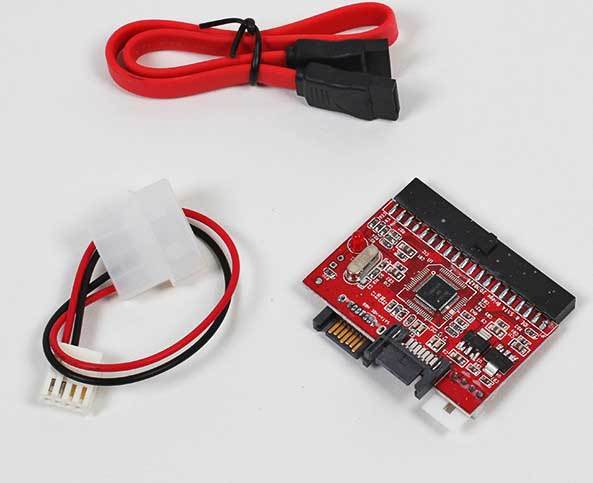
If you believe the description, then this sATA to IDE adapter and iDE to SATA adapter . Thus, you can connect not only the old hard drive with an IDE connector to the SATA motherboard, but vice versa, you can connect any drive to the motherboard that does not have SATA.
I did not check whether it works in both directions, since I do not have a motherboard with an IDE connector.
As for connecting to the motherboard via a SATA connector, everything works perfectly.
We connect the adapter itself to the IDE connector hard drive, connect the SATA cable to the adapter ( comes with) Do not forget to connect power to both the adapter and your hard drive ( a special wire is included).
Now let's talk about possible problems when connecting.
But the problem here is one and very big.
I read a lot of comments in various sources, which is very often impossible to connect a hard drive using sATA to IDE adapter .
In some cases, the BIOS does not recognize the hard drive, and in some it does not see the OS.
There are several solutions to this problem.
DECISION:
Some adapters have a jumper with two modes of operation:
2-3 IDE mainboard to SATA HDD and 1-2 SATA mainboard to IDE HDD
All you need to do is put the jumper in the desired position.
But, in my case, there is no such jumper. But there is a jumper on the hard drive itself. Depending on the manufacturer, select the desired jumper location (try setting MASTERif it does not help - set SLAVE? see screen above).
Nothing can burn or break, it is tested on itself.
For my hard drive, the mode came up MASTER.
This is how it looks with me.
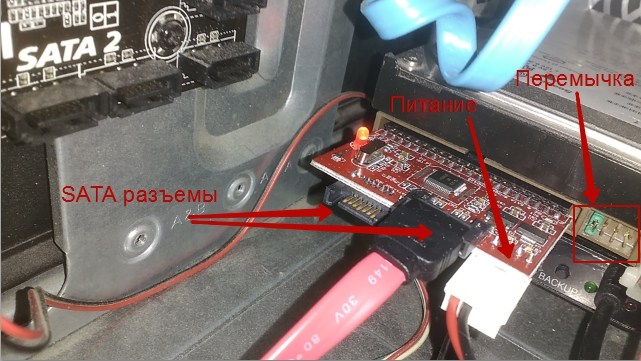
Everything would be fine, but as you remember, I started this article with installing the OS Window 7 .
Despite the fact that I used this OS before, after yesterday's installation, my computer completely refused to see the hard drive.
The solution was quite simple, I had to move the gray matter in my head and go for a trick.
Before installation (yeah, I had to reinstall the OS again, other methods did not help) I disconnected all the hard drives from power. At the same time, leaving only the one on which I install the OS.
And lo and behold, after the next cup of coffee and OS installation (connecting all the hard drives back) I saw in the folder "My computer" all of your hard drives are healthy and fully operational.
So, if you encounter a problem when connecting, do not be afraid, but experiment and you will surely succeed.
Now you know that it’s too early to send your old hard drive with an IDE connector to a landfill, and you can connect it to a motherboard with a SATA connector using iDE to SATA adapter .
If you have problems connecting, write in the comments under this article, we will understand together.
On this, I have everything.
To new and interesting articles.
Oh, I forgot to tell you:

SATA(Serial -ATA, SerialAdvancedTechnologyAttachment) Is a type of computer bus interface designed to connect to a device bus, optical drives, and others.
It was developed and presented in 2003 year, as a replacement for the now obsolete interfaceATA(AT Attachment ), also known asIDE. Later, ATAwas renamed toPATA(Parallel ATA , for better recognition and avoid confusion.
An organization calledSATA —IO (Sata international organization ), which is responsible for the development, support, and publication of new specifications for bothSATAso for SAS (Serial Attached SCSI ).
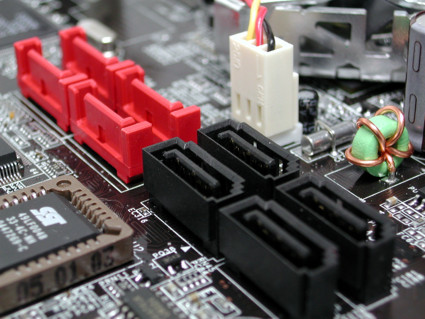
Benefits the new interface compared to the old one was like physical: reduced dimensions of connectors, loops and fewer contact legs ( 7 vs 40); like that technical: native support for hot replacements"(Replacing an inactive device), faster data transfer at higher speedsincreased queue efficiency input / output commands (I O) Later, with the advent of the regime, technology support appeared.
Theoretically, the serial port is slower than the parallel, but the speed increase was achieved thanks to high frequency operation. We managed to increase the frequency due to the absence of the need for data synchronization, as well as a greater cable security from interference (thicker conductor, less interference).
IN 2008
year, more 90%
new desktop computers used to connect peripheralsSATAconnector PATA you can still get it, but they are sold only to maintain compatibility with old drives and motherboards.
RevisionsSATA :
SATA 1. x
The first revision of the interface provides for the frequency of operation 1.5 GHzthat provides bandwidth 1.5 Gbps. Near 20%
taken away to the needs of a coding system like 8
b 10 bwhere in every 10 bit invested yet 2 bits service information. Thus, the maximum speed equals 1.2 Gbps (150 Mb / s) It's quite a bit faster than the fastest.PATA/133
but much better performance is achieved in modeAHCIwhere support worksNCQ (Native command queuing
) This greatly improves performance in multi-threaded tasks, but not all controllers support AHCI on the first version SATA.
SATA 2. x
The frequency of operation has been increased to 3.0 GHzthat increased throughput to 3.0 Gbps. Effective throughput equals 2.4Gbps (300 Mb /
c), i.e. 2 times higher than that ofSATA 1
. Compatibility
between the first and second revision preserved. The interface cables were also kept the same and fully compatible between themselves.
SATA 3.0
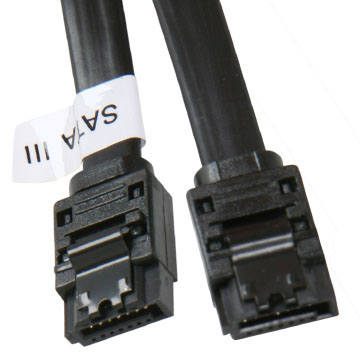
In July 2008 SATA - IO introduced specificationsSATA 3.0 with bandwidth 6 Gbps / from. Full 3.0 The standard was released in May 2009.
Effective throughput amounted to 600 Mb / s, and the frequency of functioning 6.0 GHz (that is, only the frequency is raised). Compatibility preserved both in the data transfer method and in the connectors and wires; improved power management.
The main area of \u200b\u200bapplication where such bandwidth was required -SSD (solid state) drives. For hard drives, this bandwidth was not required. The gain for them was at a higher data rate from cache (DRAM - cache) of the disk's memory.
SATA 3.1
Changes:
- · Appeared mSATA, a similar (and compatible) connector for solid state drives and laptop devices, combined with the supply line low power.
- · Standard optical drives, larger do not consume energy (at all) in mode just me.
- · Added hardware queue command that improves performance and durability SSD.
- · Hardware features identificationdefining opportunities devices.
- · Advanced nutrition managementthat allows devices connected via SATA 3.1 to consume less energy.
A Advanced H Ost C ontroller I nterface

Open host interface proposed byIntelbecome a standard. Is an more preferred device interfaceSATA. Allows the use of such commandsSATAas Hot plug (hot swap)NCQ (Native command queuing ) If in the settings motherboard not setAHCIthen used emulation IDE»And new features are not supportedSATA. Versions Windows (almost all) installed in modeIDEwill not be able to start if you start the system with the settingsAHCI. This will require special drivers AHCI, installed in the system. 2.0 and IEEE 1394 .
Major changes compared toSATA:
- · Connectors shieldedand more resistant for reusable connection.
- · Modified loss compensation signals that allowed increase maximum length cable up to 2 meters.
- · Requires connection 2 connectors single power, second interface.
eSATAp

- advanced connectore - Satabut with food from the connector. Thereby,e - Satabecomes a full-fledged portable and universal interface. With exit USB 3.0, turned out to be deprived of attention, since USB offers simpler implementation.
mSATA
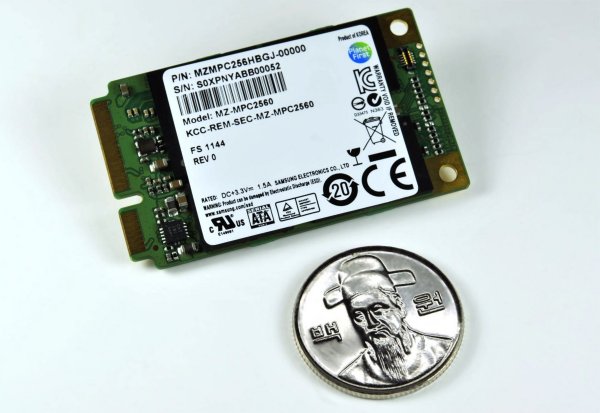
–
PCI—
e
like interface introduced in September 2009
of the year. Intended for miniature devices (solid state drives, portable hard drives). It is also planned to use in portable devices such as laptops, and other. Devices with this interface may have very tiny sizessimilar to expansion cards for laptops (for example).
Exist adapters Pata— Sata , Sata— Pata.

They allow you to connect devices with different interfaces that emulated by a special controller on the adapter. The vast majority of adapters require additional food from the power supply unit (usually of type " molex" or 5vdrive connector).
Difference IDE / SATA / SATA2 / SATA3
What is the difference between IDE and SATA?
- Interface connectors
- Data transfer principle
- Data transfer rate.
Type of HDD with IDE interface:
Type of HDD with SATA interface: 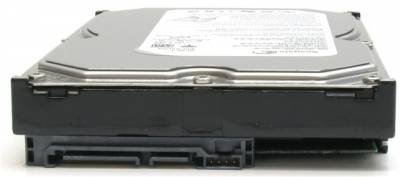
Type of HDD with SATA2 interface: 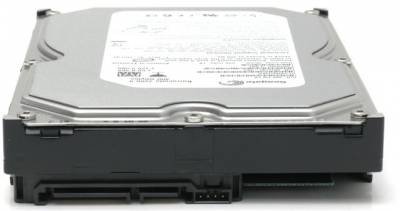
In principle, SATA and SATA II are no different. Differences in data transfer speed are 2 times.
- IDE data transfer rate is 32 - 58 Mb / s.
- SATA - 1.5Gb / s.
- SATA II - 3Gb / s.
- SATA III - 6Gb / s.
For IDE-shnyh HDDs you need your own cables and for SATA-shnyhs you need your own:
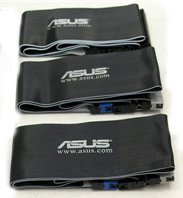

And now more about SATA / SATA2 / SATA3
SATA (Eng. Serial ATA) - a serial interface for exchanging data with information storage devices. SATA is a development of the ATA parallel interface (IDE), which after the advent of SATA was renamed to PATA (Parallel ATA).
SATA or SATA Revision 1.x (up to 1.5 Gb / s)
Initially, the SATA standard provided for the operation of the bus at a frequency of 1.5 GHz, providing a bandwidth of approximately 1.2 Gbit / s (150 MB / s). (A 20% performance loss is due to the use of the 8B / 10B coding system, in which 2 service bits are necessary for every 8 bits of useful information) The bandwidth of SATA / 150 is slightly higher than the bandwidth of the Ultra ATA bus (UDMA / 133). The main advantage of SATA over PATA is the use of a serial bus instead of a parallel one. Despite the fact that the serial exchange method is essentially slower than the parallel one, in this case it is compensated by the possibility of working at higher frequencies due to the greater noise immunity of the cable. This is achieved by fewer conductors and by combining information conductors in two twisted pairs, shielded by grounded conductors.
SATA2 or SATA Revision 2.x (up to 3 Gb / s)
The SATA / 300 standard operates at a frequency of 3 GHz, provides bandwidth up to 2.4 Gb / s (300 MB / s). It was first implemented in the NVIDIA firm's nForce 4 chipset controller. Often the SATA / 300 standard is called SATA II or SATA 2.0. Theoretically, SATA / 150 and SATA / 300 devices should be compatible (both a SATA / 300 controller with a SATA / 150 device, and a SATA / 150 controller with a SATA / 300 device) due to support for speed matching (downward), but for some devices and controllers requires manual setting of the operating mode (for example, on Seagate HDDs supporting SATA / 300, a special jumper is provided to force the SATA / 150 mode to turn on).
SATA3 or SATA Revision 3.x (up to 6 Gb / s)
The SATA Revision 3.0 specification provides the ability to transfer data at speeds up to 6 Gb / s (almost up to 4.8 Gb / s - 600 MB / s). Among the improvements SATA Revision 3.0 compared to previous version specifications, in addition to higher speed, improved power management can be noted. Also, compatibility will be preserved, both at the level of SATA connectors and cables, and at the level of exchange protocols. By the way, the SATA-IO consortium warns against the use of homegrown terms like SATA III, SATA 3.0 or SATA Gen 3 to refer to SATA generations. Full correct name specifications - SATA Revision 3.0; The name of the interface is SATA 6Gb / s.
SATA Description
SATA uses a 7-pin connector instead of the 40-pin connector on PATA. The SATA cable has a smaller area, due to which the resistance to the air blowing around the computer components is reduced, the wiring inside the system unit is simplified.
SATA cable due to its shape is more resistant to multiple connections. The SATA power cord is also designed with multiple connections in mind. The SATA power connector supplies 3 power voltages: +12 V, +5 V and +3.3 V; however, modern devices can work without a voltage of +3.3 V, which makes it possible to use a passive adapter from the standard IDE power connector to SATA. A number of SATA devices come with two power connectors: SATA and Molex.
The SATA standard abandoned the traditional PATA connection of two devices per cable; each device is supposed to have a separate cable, which removes the problem of the impossibility of simultaneous operation of devices located on the same cable (and delays resulting from this), reduces possible assembly problems (there is no problem of Slave / Master conflict of devices for SATA), eliminates the possibility of errors when using non-terminated PATA- loops.
The SATA standard supports the command queue function (NCQ starting with SATA Revision 2.x).
The SATA standard does not provide for hot swapping of the active device (used by the Operating System) (up to SATA Revision 3.x), additionally connected drives can be disconnected gradually - power, a loop, and connected in the reverse order - a loop, power. After disconnecting the drive, you need to update the configuration in the task manager.
SATA Connectors
SATA devices use two connectors: 7-pin (data bus connection) and 15-pin (power connection). The SATA standard provides the ability to use the standard 4-pin Molex connector instead of the 15-pin power connector.
Using both types of power connectors at the same time can damage the device.
The SATA interface has two data transfer channels, from controller to device and from device to controller. LVDS technology is used for signal transmission, the wires of each pair are shielded twisted pairs.
What is eSATA?
eSATA (External SATA) - an interface for connecting external devices that supports the "hot swap" mode (English Hot-plug). Was created a little later SATA (in mid-2004). Key features of eSATA:
The connectors are less fragile and are designed for a larger number of connections.
Requires two wires to connect: data bus and power cable. In the new specifications, it is planned to abandon a separate power cable for external eSATA devices.
The cable length is increased to 2 m. The average practical data transfer speed is higher than that of USB or IEEE 1394. The load on the central processor is significantly reduced. Reduced signal voltage requirements compared to SATA.
What is Power eSATA?
Initially, eSATA only transfers data. A separate cable must be used for power. MicroStar has created a new kind of eSATA connector by combining eSATA (for data) with USB (for power). The new type of connector is called Power eSATA. 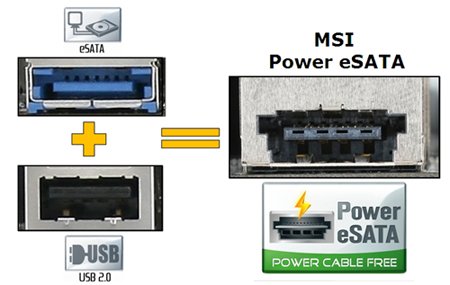
What is SAS?
Interface SAS (Eng. Serial Attached SCSI) provides connection via a physical interface similar to SATA, devices controlled by a set of SCSI commands. Having backward compatibility with SATA, it makes it possible to connect any device controlled by a set of SCSI commands via this interface - not only HDD, but also scanners, printers, etc. Compared to SATA, SAS provides a more developed topology, allowing parallel connection of one device on two or more channels. Bus extenders are also supported, allowing you to connect multiple SAS devices to a single port.
SAS and SATA2 in the first editions were synonymous. But, later, manufacturers decided that it was not practical to implement SCSI completely in desktop computers, so we are now witnessing such a separation. By the way, such high speeds inherent in the SATA standard may seem unnecessary at first glance - a regular SATA HDD uses, at best, 40-45% of the bus bandwidth. However, working with the Winchester buffer occurs at full interface speed.
Adapters from SATA to IDE and from IDE to SATA
There are boards that allow you to connect SATA devices to IDE controllers and vice versa. These are active devices (which, in fact, simulate a device and a controller in one chip). Such devices require power (usually 5 or 12 volts), connect to Molex 8981 series connectors (usually small). 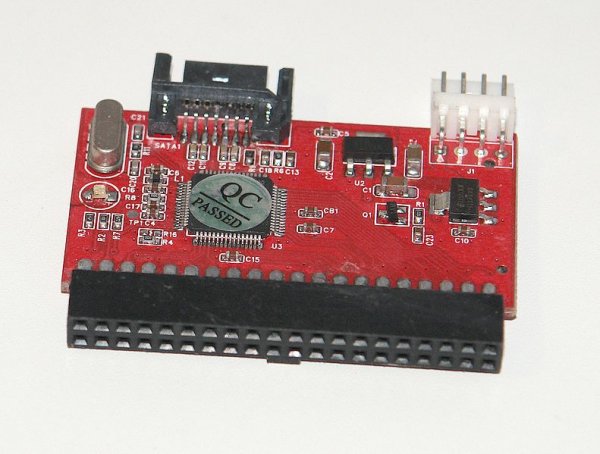
In this article, we will consider the current trend of drives, or rather, their types - magnetic and solid-state, plus, we will consider the most common interfaces for connecting hard drives. But first, let's start with a short introduction.
The trend of modern IT technologies is that you can buy any technological innovations or components at an affordable price, and there is a lot more choice compared to past times. For comparison, my first computer contained magnetic drive 2.3 GB capacity. Of course, at the moment this is ridiculous, because even simple memory cards can offer more. But that's not the point…
Due to the lack of a large selection, I had to focus only on the size of the space when buying the carrier. Over time, began to appear for a computer with a larger capacity (100, 200, 500 and even 1000 GB), with new connectors (ATA was replaced by SATA and external USB) and technological principles of work.
If you focus on the current situation, then the choice is no longer behind the volume, but behind the speed of access to data and the lifetime of the drive.
Types of hard drives - magnetic
content magnetic hard drive
I believe that many enthusiasts tried to sort out a type of hard drive for a computer, such as a magnetic one, to look at its contents (it’s good if it was already not working, otherwise someone could get a hat). If you do not go into all the technical details, then the principle of operation of the magnetic types of hard drives can be described as follows:
Inside magnetic media there are aluminum discs that are coated with a magnetic film. Using multiple magnetic disks is much better than one, because it allows you to increase the speed of access to data. Information from the media is read using magnetic heads, the disks themselves rotate at great speed. Thanks to magnetic heads, there is not only reading, but also writing information to sections (sectors). It is important to understand that the heads and the plates themselves are a mechanism that can become unusable over time - a characteristic creak during the operation of the drive may indicate this.
It is important to note that a similar technology is used in the appearance of hard USB drives, although their size is smaller than that of internal drives. So, if you open the pocket of the external drive, then there will be a simple medium with SATA connectors, which can be easily made internal. Unfortunately, the used microcircuit (serves as a SATA-USB adapter) cannot be applied to large internal (3.5 inches) SATA media, since they require additional power. You can buy a pocket for 3.5 inch drives, and connect them to your laptop as a USB drive.
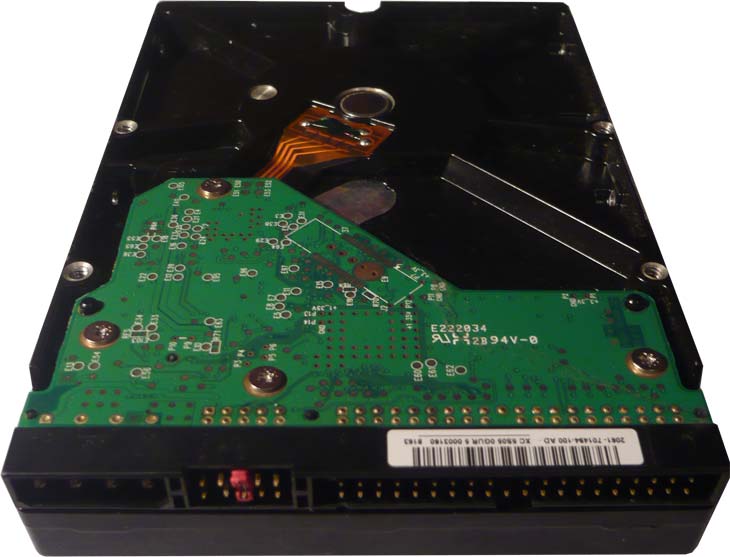
good old ATA drive
In traditional HDDs, the movable head records data on magnetic plates. Hard drives are still popular due to their low price, relatively good performance and very large volume. Currently, for the price of one HDD, you can buy an SSD even four times less capacity. And in equipment like a smartphone or tablet, only flash memory is used, that is, a solid-state SSD.
Unlike solid state types of hard drives, magnetic drives are significantly inferior to them. So, the speed of access to data depends on the speed of rotation of the disks, and can significantly fall during mechanical shakes and not only.
Solid State SSD Hard Drives

disassembled solid state SDD drive
Unlike magnetic types of hard drives for a computer, solid-state SSDs have several advantages. First of all, the absence of mechanical parts in the middle makes them more resistant to external shocks. They, in fact, are large flash drives with non-volatile memory. The connection principles are similar to the magnetic types of hard drives, but SSDs are more economical in terms of energy consumption and faster when accessing data.
Solid state hard sSD drives were designed for computers for which classic HDDs were too loose or too susceptible to mechanical damage. Used them in very powerful servers and military equipment. Initially, a solid-state SSD consisted of classic memory modules, had a small capacity, and a buffer battery was responsible for the safety of data on the media when the computer was turned off.
Of course, there are a number of disadvantages for SSDs. So, they are much more expensive than mechanical counterparts and although they are more reliable in terms of resistance to external shocks, they also have one flaw. As mentioned above, magnetic types of hard HDD drives Before their death (failure) they inform the owner in every possible way, making suspicious sounds, thereby making it possible to manage to transfer data to another drive. With SSD, such a trick will not work, if they die, then immediately, without preliminary snoring or squeaking. This is not strange, because the SSD uses chips that can burn out without making a sound.
Another important feature of SSD type of hard drives is the fact that they do not really need to defragment, because they use completely different methods of data storage.
You can also hear about hybrid drives that contain both elements of magnetic HDD and solid-state SDD. The cost of a hybrid drive is between the prices of magnetic HDDs and solid-state SSDs. You must understand that due to the presence of moving mechanical elements, the hybrid drive is also prone to damage.
Many components that are currently on the computer market make it possible to install two or more hard drives of various kinds. This allows us to use the processing power of the solid-state SSD on which to install operating systemas well as the capacity of the magnetic HDD on which data is stored.
Solid state drives rated by computer players. They are a necessary complement to any computer on which speed and processing power is important (for example, graphic stations, computers for gamers).
Many laptops, netbooks and ultrabooks use cards with SSD memory with an mSATA connector. This is an extension of the functionality of the SATA bus, known from conventional computer drives.
Hard Drive Connection Interfaces
To connect the media to the computer, you must use the appropriate slot. Before buying a magnetic (HDD) or solid-state (SSD) hard drive, you need to check what connectors our computer is equipped with, then select a drive that will be compatible with it.
Interfaces for connecting hard drives are divided into two categories: internal and external. As the names themselves show, they are used to connect internal and external types of hard drives. The first serve, first of all, for storing the most important data on a computer, which you should always have with you. On the internal storage the operating system and the most desired programs. In turn, the external drive will be able to serve as a backup data storage, on which, for example, music, video and backup copies of documents are located.
Internal Hard Drive Interface
SATA

sATA magnetic hard drive
By far, the most popular hard drive connection interface used on both desktop and laptop computers is SATA. This cable has the form of a thin tape, with which the media is connected to the computer. Unfortunately, with its help it was not possible to bring as much energy, therefore, it is necessary to connect a second power wire to the disk. The SATA interface is currently available in two versions - SATA II (3 Gb / s) and SATA III (6 Gb / s). In the case of SATA-II, the throughput is up to 375 MB / s, in turn, SATA-III, in theory, can allow data throughput at the level of 750 MB / s. In practice, these values \u200b\u200bare much lower. How to correctly read the data transfer rate is described in the article.
Both generations sATA interface do not differ from each other in terms of manufacturing, and they are completely compatible with each other. However, it is worth remembering that to fully utilize the capabilities of the hard drive type SATA III, you must have a computer equipped with a SATA III interface. You can skip this condition if you intend to buy a hard drive that is not able to use the full potential of the new interface. People who buy solid-state SSDs will notice an improvement in computer performance, even if they have an older interface, but only the new interface will get the best data transfer values. It can be added that the SATA interface replaced the popular ATA interface several years ago, which was larger and often subjected to mechanical damage and did not look very aesthetically pleasing.
SATA Express
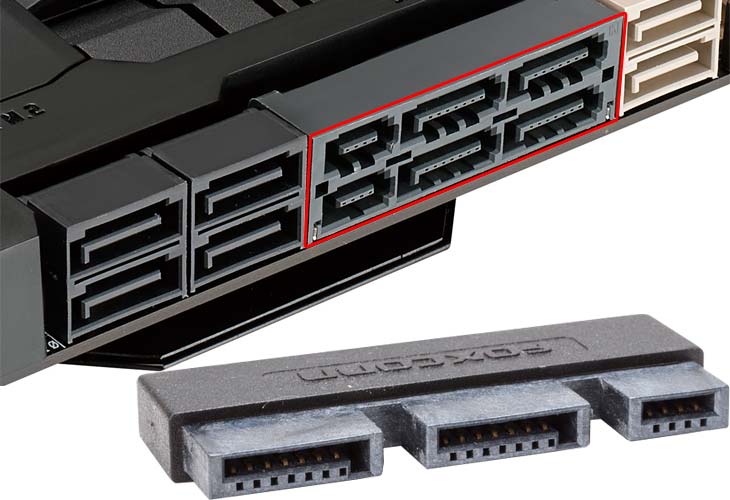
Relatively new, but with great potential, is the interface for connecting types of hard drives - SATA Express. It allows you to connect both SATA and PCI-Express. Therefore, this is not a completely new interface, but a solution for connecting existing drives. You can connect one PCI-Express channel or two SATA to the SATA Express port. In addition, when using the second solution, part of the connector remains unused. However, it should be borne in mind that the prospect of SATA Express could die a natural death in a few years.
This is because it is a transitional type of hard drive interface that provides an easy transition from SATA to high-speed PCI-Express. When SATA eventually dies, SATA Express will also quickly leave after it. The SATA Express connector is designed to remain compatible with the new connector standards that will be introduced in the future.
M. 2
![]()
mSATA connection interface on the left, m.2 on the right
A miniature version of SATA Express is the M. 2 interface. It allows you to connect media using mini-PCI-Express to your computer. Slot M. 2 occurs in various configurations that differ in type and number of supported PCI-Express lanes. Its highest-performance version allows up to four PCI-Express 3.0 lanes, which means a maximum theoretical throughput of 4 Gb / s.
Mini-sata
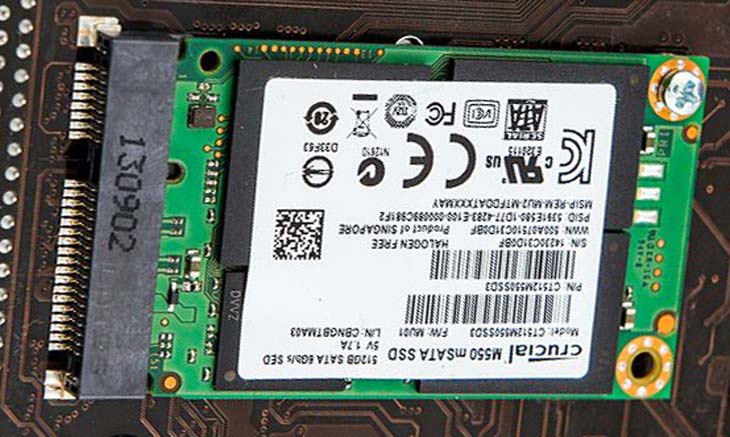
example of connecting a cruel wilderness via the mSATA connector
The mSATA (Mini-SATA) interface was created in 2009 due to the need for smaller devices for more efficient components. The connector found application primarily in netbooks, but also laptops and other devices. mSATA visually looks the same as a PCI Express Mini Card, however, they are electrically compatible with each other. The signal is also not fed to the PCI Express and SATA controller. The maximum transfer is 6 Gb / s.
PCI-Express
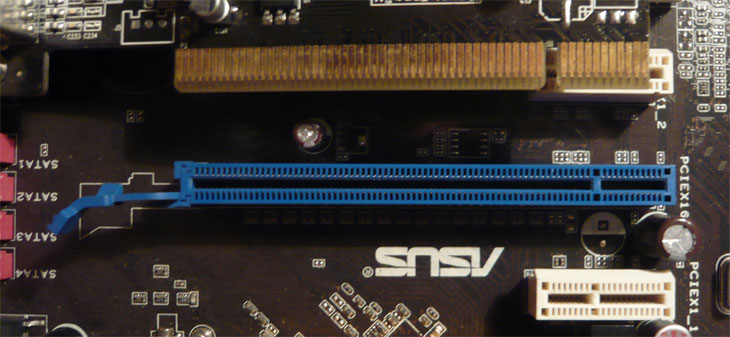
connector PCI-Express connector on the motherboard
A much less commonly used interface for connecting hard drives is PCI-Express. Manufacturers decided to use it for several reasons. The most important of them is that SATA III 6 Gb / s limits the capabilities of the latest drives, and this process will be deepened. Of course, it would be possible to create a different version of the SATA interface, however, it would consume 10% more energy than the version on the market and ... would be almost twice as slow as the PCI-Express interface. PCI-Express is also a very energy-efficient interface, which in the age of mobility is a highly desirable feature.
Another advantage of PCI-Express is the fact that its performance can be very easily changed by changing the slot width. In addition, PCI-Express is developing very fast due to the fact that other devices, such as video cards, work on it. It is expected that it should have twice as much bandwidth than the version of the interface that is currently in use. The disadvantage of types of PCI-Express hard drives is that they are expensive and incompatible with the SATA connector.
External Hard Drive Connection Interface
eSATA

sATA cable interface (left) and eSATA (right)
eSATA (external SATA) is an external SATA port. This is just a version of SATA designed for external drives. Its throughput, depending on the version, is 375 or 750 MB / s. It is worth remembering that SATA and eSATA cables are not compatible with each other. This interface was once used because of greater performance than using the USB 2.0 interface. Since the advent of USB 3.0, its popularity has been falling all the time.
USB

USB is by far the most popular type of interface for connecting external hard drives and is used in various devices. Even a complete amateur understands what USB looks like and what you can connect to it. This is because this interface has been available on the market for 15 years, and its creators, introducing the next versions of USB, took care of their backward compatibility. Although over the years the appearance of the USB interface has not changed, we are currently using the third generation of this interface, and soon another version will appear on the market. Of course, the most commonly used interface is USB 2.0. to connect external hard solid state drive. Characterized by a very low data transfer rate of 60 MB / s, for transmission large files it is very slow.
USB 3.0 is much better in this regard, with a maximum throughput of 640 MB / s. This is still less than in the case of the fastest SATA, but this speed is sufficient to transfer data between the computer and appearance hard drive. Now almost everyone external hard drive uses this standard. Of course, a USB 2.0 type hard drive can be connected to port 3.0, and everything works the other way. However, it is worth knowing that to use all the features of the USB 3.0 interface it is necessary that both the computer, the cable, and the drive support it.
Thunderbolt

Thunderbolt is a combination of two other interfaces for connecting external hard drives, magnetic and solid state, and, in particular, PCI-Express and Display Port. Thanks to this, it has the ability to transmit not only data, but also images. Further features of this interface are bandwidth up to 1250 Mb / s and the ability to connect up to 6 devices, of the same or different type. In addition, this connection interface is able to provide the device with up to 10V of energy. Admittedly, these results are no less impressive, since USB 3.0 can transfer up to two times less data, and at the same time deliver only 4.5 watts of power. Thunderbolt, mainly used in apple computersbut it also slowly enters for use in equipment of other manufacturers.
As if that were not enough, the second generation of Thunderbolta is entering the market. Its most important feature is twice the bandwidth than the first Thunderbolta and up to 20 Gb / s. Thanks to this, it will be possible to transfer with its help images with a resolution of 4K, which takes up four times the area than similar files in 1080p resolution.
A drive interface is a set of electronics that provides the exchange of information between a device controller (cache buffer) and a computer. Currently, IBM-PC desktops, more often than others, use two types of ATAPI interfaces - AT Attachment Packet Interface (Integrated Drive Electronics - IDE, Enhanced Integrated Drive Electronics - EIDE) and SCSI (Small Computers System Interface).
InterfaceIDE It was developed as an inexpensive and productive alternative to high-speed ESDI and SCSI interfaces. Interface designed to connect two disk devices. A distinctive feature of disk devices working with the IDE interface is that the disk drive controller itself is located on the drive board itself, along with a built-in internal cache buffer. This design greatly simplifies the device of the interface card itself and makes it possible to place it not only on a separate adapter board that is inserted into the system bus connector, but also integrate it directly on the computer's motherboard. The interface is characterized by extreme simplicity, high speed, small size and relative low cost.
Drive adapter interface diagrams in the IDE
Today, the IDE interface has been replaced by the brainchild of Western Digital - Enhanced IDE, or EIDE for short. Now this is the best option for the vast majority of desktop systems. EIDE hard drives are noticeably cheaper than similar in capacity SCSI disks and in single-user systems are not inferior to them in performance, and most motherboard have an integrated dual-channel controller for connecting four devices. What is new in the Enhanced IDE compared to the IDE?
The first is the large capacity of the drives. If the IDE did not support drives over 528 megabytes, then EIDE supports volumes up to 8.4 gigabytes per controller channel.
Secondly, more devices are connected to it - four instead of two. Previously, there was only one controller channel to which two IDE devices could be connected. Now there are two such channels. The main channel, which usually stands on the high-speed local bus and auxiliary.
Thirdly, the ATAPI (AT Attachment Packet Interface) specification appeared, which makes it possible to connect not only hard disks to this interface, but also other devices - streamers and CD-ROM drives.
Fourth, productivity has improved. Drives with an IDE interface were characterized by a maximum data transfer rate of 3 megabytes per second. Hard disks EIDE supports several new communication modes. These include PIO (Programmed Input / Output) Mode 3 and 4, which provide data rates of 11.1 and 16.6 megabytes per second, respectively. Programmable I / O is a way of transferring data between the controller of a peripheral device and the computer’s main memory using data transfer commands and I / O ports of the central processor.
Fifthly, the Direct Memory Access mode is supported - Multiword Mode 1 DMA (Direct Memory Access) or Multiword Mode 2 DMA and Ultra DMA, which support data exchange in exclusive mode (that is, when the I / O channel has been serving only one for some time device). DMA is another way to transfer data from a peripheral controller to random access memory computer, it differs from PIO in that the central processor of the PC is not involved and its resources remain free for other tasks. Peripheral devices are served by a special DMA controller. The speed in this case reaches 13.3 and 16.6 megabytes per second, and when using Ultra DMA and the corresponding bus driver - 33 megabytes per second. EIDE controllers use the PIO mechanism in the same way as some SCSI adapters do, but high-speed SCSI adapters work only according to the DMA method.
In the sixth, the system of commands for controlling the device, transmitting data and diagnostics was expanded, the cache buffer for data exchange was increased, and the mechanics were significantly improved.
Instead of the EIDE specification, Seagate and Quantum use the Fast ATA specification for drives supporting PIO Mode 3 and DMA Mode 1, while those operating in PIO Mode 4 and DMA Mode 2 are designated Fast ATA-2.
Intelligent multi-function interfaceSCSI was developed back in the late 70s as a device for interfacing a computer and an intelligent disk drive controller. The SCSI interface is universal and defines a data bus between the central processor and several external devices that have their own controller. In addition to the electrical and physical parameters, commands are also determined by which devices connected to the bus communicate with each other. The SCSI interface does not define in detail the processes on both sides of the bus and is a pure interface. The SCSI interface supports a much wider range of peripherals and is standardized by ANSI (X3.131-1986).
Today, two standards are mainly used - SCSI-2 and Ultra SCSI. In Fast SCSI-2 mode, the data transfer rate reaches 10 megabytes per second when using the 8-bit bus and up to 20 megabytes with the 16-bit Fast Wide SCSI-2 bus. The later Ultra SCSI standard is even more powerful - 20 megabytes per second for the 8-bit bus and 40 megabytes for the 16-bit bus. The latest SCSI-3 has a larger set of commands, but the performance remains at the same level. All applicable standards are compatible with previous versions.

Pairing external devices in a SCSI interface
from top to bottom, that is, you can connect old SCSI devices to SCSI-2 and Ultra SCSI adapters. SCSI-Wide, SCSI-2, SCSI-3 - standards for modifying the SCSI interface, developed by the ANSI committee. The general concept of improvements is aimed at increasing the bus width to 32, with an increase in the length of the connecting cable and maximum data transfer rate while maintaining compatibility with SCSI. This is the most flexible and standardized type of interface used to connect 7 or more peripherals equipped with a SCSI interface controller. The SCSI interface remains quite expensive and the highest performance of the family of peripherals for personal computers, and to connect a drive with a SCSI interface, you must additionally install an adapter, because few motherboards have an integrated SCSI adapter.




